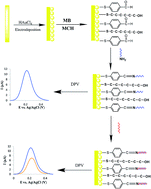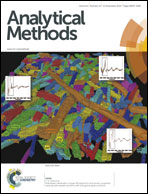A highly sensitive and selective hepatitis B DNA biosensor using gold nanoparticle electrodeposition on an Au electrode and mercaptobenzaldehyde†
Abstract
A new procedure for fabricating a hepatitis B virus (HBV-DNA) electrochemical biosensor was developed based on covalent immobilization of probe NH2-labeled HBV-DNA on a gold nano-particle electrodeposited Au electrode that had been functionalised with a self-assembled monolayer of mercapto-benzaldehyde. First, gold nanoparticles were functionalised onto a gold electrode by a simple one-step electrodeposition method. Then, mercapto-benzaldehyde was self-assembled onto the electrode surface through the Au–S bond. Mercapto-benzaldehyde was applied as an arm linker to covalently graft the 5′-amino modified HBV-DNA to the gold nano-particle electrodeposited Au electrode surface via the facile aldehyde–ammonia condensation reaction. The whole DNA biosensor fabrication process was characterized by cyclic voltammetry (CV) and electrochemical impedance spectroscopy (EIS) using [Fe(CN)6]3−/4− as an electrochemical redox indicator. The probe DNA immobilization and hybridization on the modified electrode were further studied by differential pulse voltammetry (DPV) using ferricyanide as an indicator probe. A linear detection range of the HBV-DNA was obtained from 5.7(±0.1) × 10−11 to 6.6(±0.1) × 10−8 mol L−1 with a detection limit of 7.6(±0.1) × 10−12 mol L−1.


 Please wait while we load your content...
Please wait while we load your content...